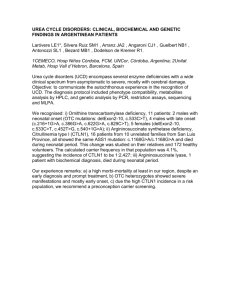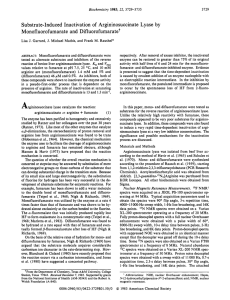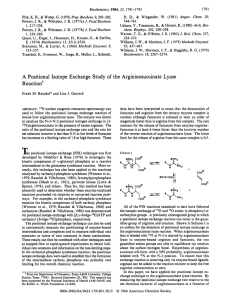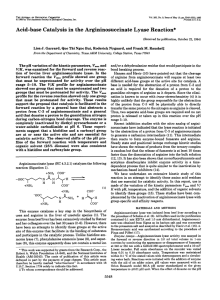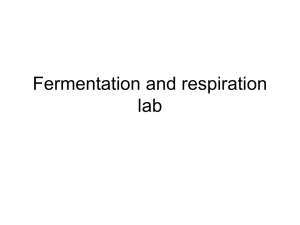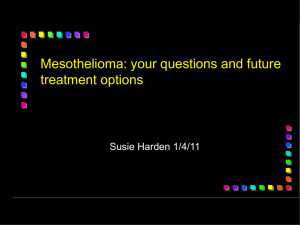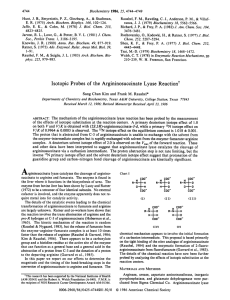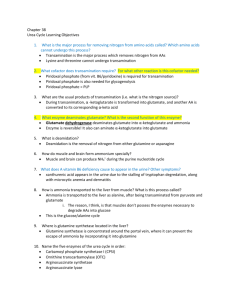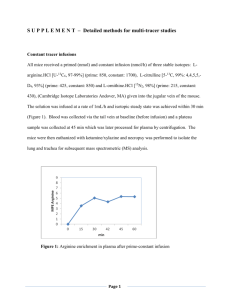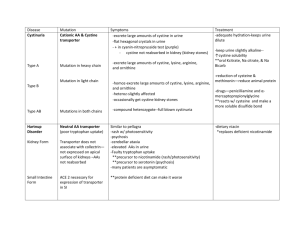Kinetic Mechanism of Bovine Liver ... Lyase’ FRANK M. RAUSHEL* RODERICK NYGAARD
advertisement
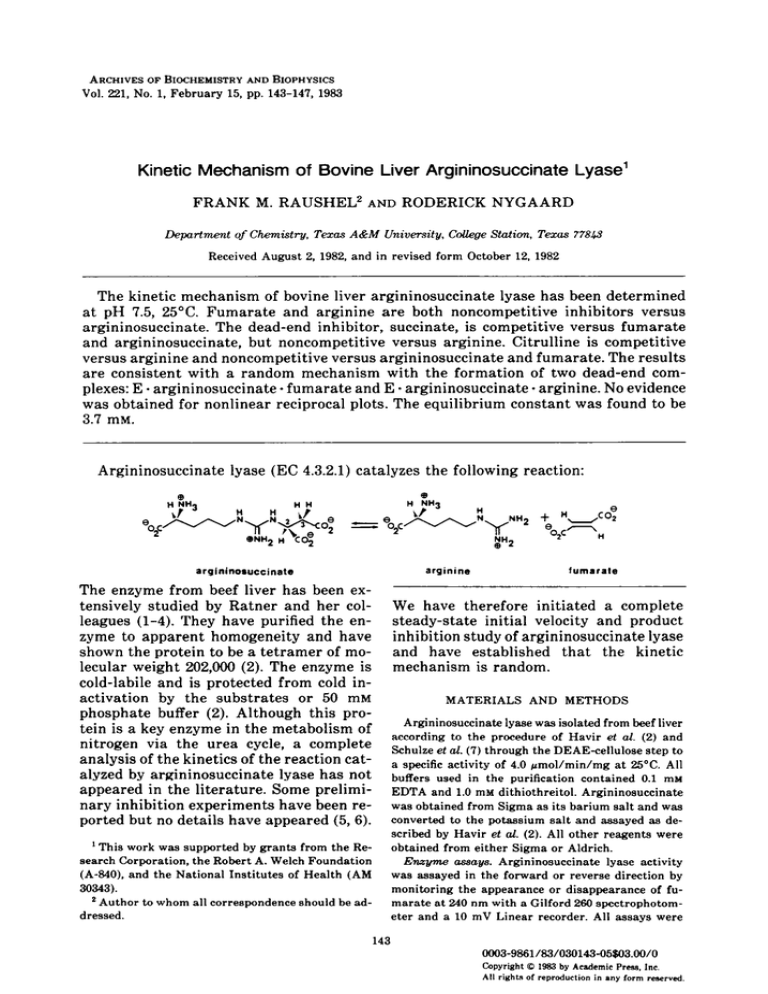
ARCHIVES OF BIOCHEMISTRY Vol. 221, No. 1. February AND BIOPHYSICS 15, pp. 143-14’7, 1983 Kinetic Mechanism of Bovine Liver Argininosuccinate FRANK M. RAUSHEL* Department of Chemistry, AND Texas A&M Lyase’ RODERICK NYGAARD University, Cdlege Station, Texus 77843 Received August 2, 1982, and in revised form October 12. 1982 The kinetic mechanism of bovine liver argininosuccinate lyase has been determined at pH 7.5, 25°C. Fumarate and arginine are both noncompetitive inhibitors versus argininosuccinate. The dead-end inhibitor, succinate, is competitive versus fumarate and argininosuccinate, but noncompetitive versus arginine. Citrulline is competitive versus arginine and noncompetitive versus argininosuccinate and fumarate. The results are consistent with a random mechanism with the formation of two dead-end complexes: E - argininosuccinate - fumarate and E - argininosuccinate * arginine. No evidence was obtained for nonlinear reciprocal plots. The equilibrium constant was found to be 3.7 rnM. Argininosuccinate lyase (EC 4.3.2.1) catalyzes the following reaction: arginine argininosuccinate The enzyme from beef liver has been extensively studied by Ratner and her colleagues (l-4). They have purified the enzyme to apparent homogeneity and have shown the protein to be a tetramer of molecular weight 202,000 (2). The enzyme is cold-labile and is protected from cold inactivation by the substrates or 50 mM phosphate buffer (2). Although this protein is a key enzyme in the metabolism of nitrogen via the urea cycle, a complete analysis of the kinetics of the reaction catalyzed by argininosuccinate lyase has not appeared in the literature. Some preliminary inhibition experiments have been reported but no details have appeared (5,6). fumarrte We have therefore initiated a complete steady-state initial velocity and product inhibition study of argininosuccinate lyase and have established that the kinetic mechanism is random. MATERIALS AND METHODS Argininosuccinate lyase was isolated from beef liver according to the procedure of Havir et al. (2) and Schulze et al. (7) through the DEAE-cellulose step to a specific activity of 4.0 amol/min/mg at 25°C. All buffers used in the purification contained 0.1 mb( EDTA and 1.0 mM dithiothreitol. Argininosuccinate was obtained from Sigma as its barium salt and was converted to the potassium salt and assayed as described by Havir et al. (2). All other reagents were obtained from either Sigma or Aldrich. Enzyme assays. Argininosuccinate lyase activity was assayed in the forward or reverse direction by monitoring the appearance or disappearance of fumarate at 2.40 nm with a Gilford 260 spectrophotometer and a 10 mV Linear recorder. All assays were 1 This work was supported by grants from the Research Corporation, the Robert A. Welch Foundation (A-840), and the National Institutes of Health (AM 30343). ‘Author to whom all correspondence should be addressed. 143 ooo3-9861/83/030143~5~3.00/0 Copyright All righta 0 1983 by Academic Press. Inc. of reproduction in any form reserved. 144 RAUSHEL AND NYGAARD mM argininosuccinate. The Michaelis constant from a fit to Eq. [2] is 51 + 5 PM. Initial velocitl/ patterns. When arginine is varied at changing fixed concentrations of fumarate an intersecting double reciprocal plot is obtained. The kinetic constants from a fit of the data to Eq. [3] are shown in Table I. There is no indication in any of these experiments for nonlinear ret ciprocal plots. The ratio of maximal ve10 20 30 -1 locities for the forward and reverse reac11 Argininosuctinote, mM tions at pH 7.5 is 0.6. FIG. 1. Variation of activity with argininosuccinate Product and dead-end inhibition. In the concentration. Conditions: 50 mM N-2-hydroxyethylforward reaction both fumarate and arpiperazine-N’-2-ethanesulfonic acid, pH 7.5, 100 mre ginine were found to be linear noncomKCl, 25°C. The velocities are in arbitrary units. petitive inhibitors versus argininosuccinate. Succinate was found to be a competitive inhibitor versus fumarate and ardone at 25°C. Each 3-ml cuvette contained 50 mM N2-hydroxyethylpiperazine-N’-2-ethanesulfonic acid, gininosuccinate but a noncompetitive inpH 7.5, 100 mM KCl, and substrates and inhibitors hibitor versus arginine. Citrulline was as indicated in the individual experiments. All recompetitive versus arginine and noncomactions were initiated by the addition of argininopetitive versus fumarate and argininosucsuccinate lyase (0.05-0.15 units) with the aid of an cinate. The kinetic constants from fits of adder-mixer. the inhibition data to Eqs. [4] and [5] apData analysis. Reciprocal velocities were plotted pear in Table II. graphically against reciprocals of substrate concenEquilibrium constant. The equilibrium tration and the data were fitted to Eq. [2], assuming constant for the reaction catalyzed by arequal variances for the velocities and using the Forgininosuccinate lyase was determined at tran programs of Cleland (8). Data for a sequential initial velocity pattern were fitted to Eq. [3], for compH 7.5 by making up reaction mixtures that petitive inhibition to Eq. [4], for noncompetitive inwere initially 0.470 mM in fumarate and inhibition hibition to Eq. [5] and for uncompetitive variable in arginine (2.5-5.0 mM). Enzyme to Eq. [6]. The nomenclature used in this paper is was added and the AM was monitored unthat of Cleland (9) til the reaction was complete. The final concentrations of the substrates and prodPI ucts were calculated from the AAm using a millimolar extinction coefficient of 2.44 VAB for fumarate (9). The equilibrium con[31 ’ = Ki.Kb + KbA + KSB + AB stant, defined as: ’ = K(l VA + (I/Kis)) ’ = K(l + (I/Kis)) [fumarate] [arginine] [argininosuccinate] + A VA + A(1 + I/Kii)) VA ’ = K + A(1 + I/Kii)) [51 PI RESULTS Variation of arginirwsuccinhxte. The variation of activity with argininosuccinate concentration is shown in Fig. 1. As can be seen from the data, the double reciprocal plot is linear from 30 pM to 1.0 TABLE I KINETIC CONSTANTS FROM INITIAL VELOCITY EXPERIMENTS’ Substrate Argininosuccinste Fumarate L-Arginine K MM) 0.051 f 0.005 0.06 f 0.01 0.28 * 0.04 Ki 6~) - 0.65 f 0.1 2.9 + 0.6 Rel V 100 170 * From fits to Eqs. [2] and [3] of the data at pH 7.5, 25-Z, 100 mM KCI. KINETICS OF ARGININOSUCCINATE TABLE 145 LYASE II PRODLJC~AND DEAD-END INHIBITION CQNSTANTF?~ Inhibitor Variable substrate L-Arginine Fumarate Citrulline Succinate Argininosuccinate Argininosuccinate Argininosuccinate Argininosuccinate Succinate Succinate Citrulline Citrulline Fumarate Arginine Arginine Fumarate Fixed substrate (mM) & (mW Kii (mW Inhibition - 8.0 L 1.5 0.47 + 0.09 39 + 3 8325 20 c 2 0.90 k 0.06 640 k 60 - NC NC NC C Arginine, 0.75 Fumarate, 0.50 Fumarate, 0.50 Arginine, 0.75 34+2 54f6 3.9 + 0.2 14 f 4 195 + 33 921 C NC C NC ’ From fits to Eqs. [4], [5], and [6] of the data at pH ‘7.5, 25°C. 100 mrd KCI. b The double reciprocal plots can be found in the Miniprint Supplement. is 3.7 + 0.1 mM from an average of six determinations. DISCUSSION Argininosuccinate lyase from beef liver has previously been reported to have nonlinear double reciprocal plots for the cleavage of argininosuccinate to arginine and fumarate (4). With our reaction conditions we have obtained linear plots in all cases for all substrates. The reason for this difference is not clear but the purified enzyme from human liver has recently been shown in two independent reports to exhibit normal Michaelis-Menten kinetics (11, 12). The equilibrium constant for argininosuccinate lyase of 3.7 mM is in good agreement with the value of 3.22 mM as determined by Kuchel et al. (6) but is not consistent with the value of 11.4 mM at 38°C as reported by Ratner (5). The inhibition experiments with the product and dead-end inhibitors are consistent with a random Uni-Bi kinetic mechanism for bovine liver argininosuccinate lyase. It has previously been shown that compounds that resemble the substrates in structure but do not chemically react can be used to establish the order of addition and release of substrates from the active sites of enzymes (13). In this study succinate has been used as a dead-end inhibitor for fumarate and citrulline as a dead-end inhibitor for arginine. Both of these compounds gave the expected competitive inhibition patterns versus the compounds they were expected to mimic. Succinate and citrulline were also found to be noncompetitive inhibitors versus arginine and fumarate, respectively. This establishes that the order of addition of fumarate and arginine to the enzyme must be random since if there was an obligatory order of addition to the enzyme, one of these inhibition patterns would have been uncompetitive. For example, if arginine added before fumarate then succinate would be expected to be uncompetitive versus arginine. If the addition or release of arginine and fumarate from the enzyme was completely random then both of these compounds would be expected to be competitive inhibitors versus argininosuccinate since all substrates and products would be able to combine with free enzyme. However, both of these compounds are noncompetitive inhibitors versus argininosuccinate. This indicates that two dead-end complexes are able to form: Es argininosuccinate + arginine and Es argininosuccinate . fuarate. The dead-end complex, Es argininouccinate * citrulline, also forms as indicated by the noncompetitive inhibition of citrulline with argininosuccinate as the variable substrate, although the Kii is greater than 10 times the Ki,. Since succinate is a competitive inhibitor versus argininosuccinate, a dead-end complex with 146 RAUSHEL AND argininosuccinate and succinate is apparently unable to form. The active site of argininosuccinate lyase is thus able to accommodate the binding of argininosuccinate and one of the two products at the same time. This situation is commonly seen with kinases in which both ATP and the phosphorylated product are able to bind at the active site at the same time and thus give noncompetitive inhibition patterns (13,14). REFERENCES 1. HOBERMAN, H. D., HAVIR, E. A., ROCHOVANSICY, O., AND RATNER, S. (1964) J. Bid Chem 239, 3818. 2. HAVIR, E. A., TAMIR, H., RATNER, S., AND WARNER, R. C. (1965) J. Bid C&m 240, 3079. 3. LUSTY, C. J., AND RATNER, S. (1972) J. Bid Chem. 247.7010. NYGAARD 0. (1975) J. Bid Ch.en~ 260.7225. 5. RATNER, S. (1972) in The Enzymes (Boyer, P., ed.), Vol. VII, p. 167, Academic Press, New York. 4. ROCHOVANSKY, 6. KUCHEL, P. W., NICHOL, L. W., AND JEFFERY, Biophys. Ada 397, 478. P. D. (1975) B&him 7. SCHIJLZE, I. T., LUSTY, C. J., AND RATNER, S. (1970) J. BioL Chem. 245.4534. W. W. (1967) Advan EnzymoL 29.1. W. W. (1963) Btihim Biqvhys Actu 67, 104. 8. CLELAND, 9. CLELAND. 10. ALBERTY, R. A., MASSEY, V., FRIEDEN, C., AND FUHLBRIGCE, A. R. (1954) J. Amer. Chem Sot 76, 2485. 11. O’BRIEN, W. E. AND BARR, R. H. (1981) Biochem- istry 20.2056. A. G., AND MANTAGOS, S. (1981)5. Bid Chem. 256, 9192. 13. CLELAND. W. W. (1970) in The Enzymes (Bayer, P. ed.), Vol. II, p. 1, Academic Press, New York. 14. RAUSHEL, F. M., AND CLELAND, W. W. (1977) Bie chemistry 16.2169. 12. PALEKAR, KINETICS OF ARGININOSUCCINATE MINIPRINT LYASE 147 SUPPLEMENT -0 I/fumarat., mM-’ a Figure 1A: Double reciprocal plots for the initial velocity and product inhibition data that are presented in Tables I and II. Additional details are given in the text. Velocities are in arbitrary units. A: fumarate vs. arginine (a,b,c,d and e are 1.0, 0.31, 0.18, 0.13 and 0.10 nEl fumarate. respectively) 6: arginine vs. argininosuccinate (a,b,c and d are 0, 3.0, 6.0,and 9.0 HI arginine, respectively) C: fumarate vs. argininosuccinate (a,b,c and d are 0, 0.3. 0.6.and 0.9 rM4 fumarate, respectively) D: citrulline VS. argininosuccinate (a,b$ and dare 0, 50, 100 and 150 ni4 citrulline. respectively) E: succinate vs. argininosuccinate (a,b,c and d are 0. 40, @I and 120 nH succinate, respectively) F: succinate vs. fumarate (a,b c and d are 0, 3U, 60 and 90 ti succinate, respectively) G: succinate VS. arginiw (a,b,c and d are 0, 30, 60 and 90 Ml succinate, respectively) H: citrulline vs. arginine (a,b,c,d,e and f are 0, 2.0, 4.0, 6.0, 8.0 and 10.0 nM citrulline, respectively) I: citrulline vs. fumarate (a.b,c,d and e are 0, 2.5, 5.0, 7.5 and 10.0 n#4 citrullire, respectively)
